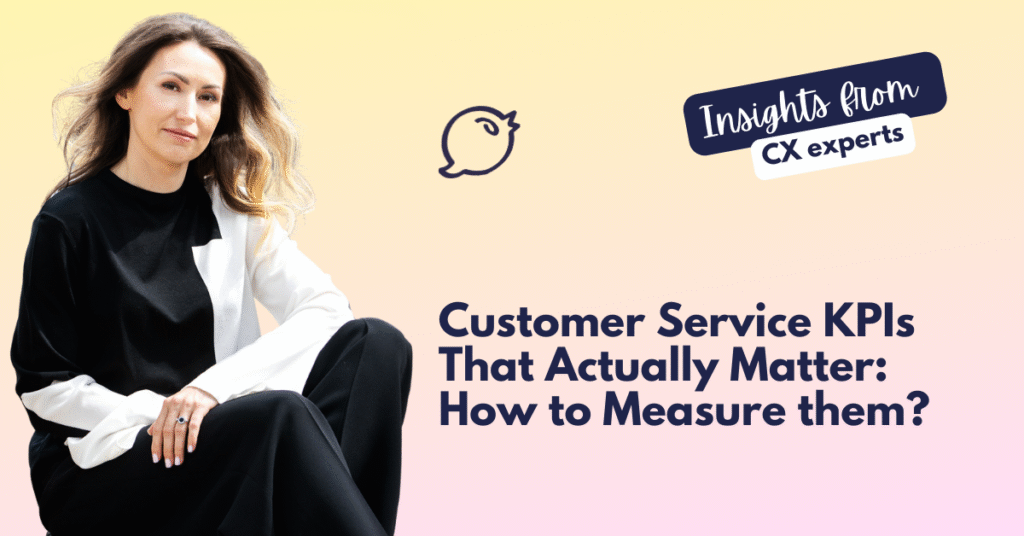Customer Service KPIs That Actually Matter: How to Measure them?

Sandra Roosna
Askly CEO & Founder

As someone who’s spent years in customer service and technology, I’ve noticed a common trap: leaders track too much or too little, but improve nothing. The data does not give clear signals. It may even look impressive, but half the time teams don’t know which metrics affect their growth.
Key Performance Indicators (KPIs) are supposed to guide us, not just be there on our meeting slides. The trick isn’t collecting them, it’s knowing which ones deserve your energy.
Over the years, I’ve found a handful of KPIs that consistently separate the companies delivering “okay” service from the ones customers adore. I have been focusing on written customer service in my studies and surveys (chats on websites, social media channels and emails).
The KPIs That Shape Customer Service Performance
First Response Time (FRT).
This one is simple: the faster you respond, the more your customers feel heard. In practice, shaving even 30 seconds off can be the difference between a curious browser sticking around or bouncing. One of our clients dropped their average FRT under a minute, and immediately saw conversion rates lift — not because their answers were perfect, but because customers felt acknowledged.
Average Resolution Time (ART).
Nobody wants to chat for half an hour about a billing glitch. A shorter ART usually means your agents are better trained, have better tools, or both. I always tell teams: don’t obsess over speed alone. Solve properly once, and you’ll handle more chats in the long run.
First Contact Resolution (FCR).
This is my personal favorite. If customers need to come back two or three times for the same issue, you’re losing trust. Companies with strong FCR numbers don’t just resolve tickets. They keep people coming back as loyal buyers.
Customer Satisfaction (CSAT).
Yes, surveys can feel repetitive, but a simple “How did we do?” after a chat uncovers things data points can’t. If your CSAT drops below 80–85%, that’s usually an early warning sign of bigger issues brewing in your service process.
Net Promoter Score (NPS).
This one goes beyond the chat window: “Would you recommend us?” When customers say yes, it means you didn’t just fix their problem. You left them with enough goodwill to tell a friend. In today’s word-of-mouth economy, that’s gold.
Measuring Chat Quality Without Overcomplicating It
You don’t need a PhD in analytics to measure customer service quality. Start simple:
- Read transcripts. You’ll learn more about tone, empathy, and problem-solving from one chat log than from a month of charts.
- Ask for feedback. Customers are rarely shy about telling you if an interaction feels robotic.
- Watch peak times. If your team collapses every Monday morning at 9 a.m., you don’t have a “customer problem.” You have a staffing problem.
The best leaders I’ve worked with balance hard numbers with human judgment. Don’t just measure what’s easy to track. Measure what actually changes customer perception.
What “Good” Looks Like in Customer Service
Benchmarks are useful, but they’re not gospel. Still, here are some standards I use as reference points:
- First Response Time: under 60 seconds.
- Average Resolution Time: 10–15 minutes.
- First Contact Resolution: at least 70%.
- Customer Satisfaction: above 85%.
If you’re in enterprise, the margins matter. An FCR of 75% vs. 60% might look small, but across thousands of chats, it’s the difference between a lean, happy team and a burned-out one.
Beyond KPIs: Measuring Real Success
Here’s the truth: KPIs are only the beginning. The real question is whether live chat drives business outcomes.
- Conversions. Live chat should move the sales needle. If people chat and don’t buy, something’s broken.
- Retention. Does your chat experience make people want to come back?
- Abandonment. If customers are leaving chats midway, it’s often a symptom of wait times or poor training.
- Agent capacity. Your people aren’t robots. Six to seven chats at a time is usually sustainable, more than that and quality drops.
The most successful teams I’ve seen aren’t just chasing metrics. They’re using KPIs as signals, then stepping back to ask: are we making customers’ lives easier?
How to Actually Improve Live Chat KPIs
There’s no silver bullet, but I’ve seen a few strategies work time and again:
- Invest in training. Tools matter, but nothing replaces an agent who knows the product inside out.
- Lean on automation. A smart chatbot can cut first response times to near zero, freeing your human team for the complex, high-value conversations.
- Build a strong knowledge base. Every time an agent repeats the same answer, that’s knowledge that should have been documented.
- Encourage sharing. Some of the best fixes come from one teammate teaching another how they solved a tricky case.
At Askly, we’ve designed analytics that make it easy to spot trends before they become problems. But the real differentiator is culture. Teams that treat KPIs as tools, not goals, consistently deliver better experiences.
Final Thoughts
Support metrics are important, but they’re not the endgame. Customers don’t remember if your resolution time was 11 minutes or 14. They remember whether the interaction felt smooth, empathetic, and helpful.
So yes, track ART, FCR, CSAT, NPS. But use them as a compass, not a scoreboard. The ultimate measure of success? When your customers leave a chat saying, “That was easy.”
One extra tip!
Success in e-commerce comes from earning trust at scale: with design, customer service, storytelling, and consistency in place.
At Askly, we’ve seen firsthand how the right tools — especially in customer support — can make the difference between abandoned carts and loyal repeat buyers.
Sometimes, just one change can transform your store’s sales.
We have worked with 1000+ e-stores, big and small, and helped them grow sales and build trust with Askly software.
It is a simple plugin with massive AI-powered opportunities for customer communication. For example, Askly AI Assistant replies to customers on your website, FB and IG DMs 24/7 in 30 languages. You can try it free (no obligations) here.
About the author

Sandra Roosna
Askly CEO & Founder
Sandra Roosna is the founder and CEO of Askly, a multilingual customer support platform for e-commerce. With a background in international business and experience from Y Combinator’s Startup School, she built Askly to help online stores improve customer communication across Europe.
Want more happy customers with a small team? Askly can easily help you achieve it.
Free trial. No obligations. Start growing you business tomorrow.
Recent posts
AI in customer service that finally works.
No costs. No obligations.
